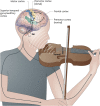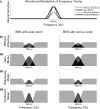Music-induced cortical plasticity and lateral inhibition in the human auditory cortex as foundations for tonal tinnitus treatment
- PMID: 22754508
- PMCID: PMC3384223
- DOI: 10.3389/fnsys.2012.00050
Music-induced cortical plasticity and lateral inhibition in the human auditory cortex as foundations for tonal tinnitus treatment
Abstract
Over the past 15 years, we have studied plasticity in the human auditory cortex by means of magnetoencephalography (MEG). Two main topics nurtured our curiosity: the effects of musical training on plasticity in the auditory system, and the effects of lateral inhibition. One of our plasticity studies found that listening to notched music for 3 h inhibited the neuronal activity in the auditory cortex that corresponded to the center-frequency of the notch, suggesting suppression of neural activity by lateral inhibition. Subsequent research on this topic found that suppression was notably dependent upon the notch width employed, that the lower notch-edge induced stronger attenuation of neural activity than the higher notch-edge, and that auditory focused attention strengthened the inhibitory networks. Crucially, the overall effects of lateral inhibition on human auditory cortical activity were stronger than the habituation effects. Based on these results we developed a novel treatment strategy for tonal tinnitus-tailor-made notched music training (TMNMT). By notching the music energy spectrum around the individual tinnitus frequency, we intended to attract lateral inhibition to auditory neurons involved in tinnitus perception. So far, the training strategy has been evaluated in two studies. The results of the initial long-term controlled study (12 months) supported the validity of the treatment concept: subjective tinnitus loudness and annoyance were significantly reduced after TMNMT but not when notching spared the tinnitus frequencies. Correspondingly, tinnitus-related auditory evoked fields (AEFs) were significantly reduced after training. The subsequent short-term (5 days) training study indicated that training was more effective in the case of tinnitus frequencies ≤ 8 kHz compared to tinnitus frequencies >8 kHz, and that training should be employed over a long-term in order to induce more persistent effects. Further development and evaluation of TMNMT therapy are planned. A goal is to transfer this novel, completely non-invasive and low-cost treatment approach for tonal tinnitus into routine clinical practice.
Keywords: human auditory cortex; lateral inhibition; music-induced cortical plasticity; tailor-made notched music training; tonal tinnitus treatment.
Figures










Similar articles
-
Impact of Spectral Notch Width on Neurophysiological Plasticity and Clinical Effectiveness of the Tailor-Made Notched Music Training.PLoS One. 2015 Sep 25;10(9):e0138595. doi: 10.1371/journal.pone.0138595. eCollection 2015. PLoS One. 2015. PMID: 26406446 Free PMC article.
-
Clinical trial on tonal tinnitus with tailor-made notched music training.BMC Neurol. 2016 Mar 17;16:38. doi: 10.1186/s12883-016-0558-7. BMC Neurol. 2016. PMID: 26987755 Free PMC article. Clinical Trial.
-
Short and intense tailor-made notched music training against tinnitus: the tinnitus frequency matters.PLoS One. 2011;6(9):e24685. doi: 10.1371/journal.pone.0024685. Epub 2011 Sep 15. PLoS One. 2011. PMID: 21935438 Free PMC article. Clinical Trial.
-
Plasticity of the human auditory cortex related to musical training.Neurosci Biobehav Rev. 2011 Nov;35(10):2140-54. doi: 10.1016/j.neubiorev.2011.06.010. Epub 2011 Jul 6. Neurosci Biobehav Rev. 2011. PMID: 21763342 Review.
-
The effect of music therapy on tinnitus: A systematic review.Medicine (Baltimore). 2023 Dec 15;102(50):e36199. doi: 10.1097/MD.0000000000036199. Medicine (Baltimore). 2023. PMID: 38115355 Free PMC article.
Cited by
-
Combining transcranial direct current stimulation and tailor-made notched music training to decrease tinnitus-related distress--a pilot study.PLoS One. 2014 Feb 25;9(2):e89904. doi: 10.1371/journal.pone.0089904. eCollection 2014. PLoS One. 2014. PMID: 24587113 Free PMC article. Clinical Trial.
-
Manipulation of Auditory Inputs as Rehabilitation Therapy for Maladaptive Auditory Cortical Reorganization.Neural Plast. 2018 May 20;2018:2546250. doi: 10.1155/2018/2546250. eCollection 2018. Neural Plast. 2018. PMID: 29887880 Free PMC article. Review.
-
Enriched Acoustic Environment as a customized treatment for tinnitus: A non-controlled longitudinal study.J Otol. 2024 Apr;19(2):63-71. doi: 10.1016/j.joto.2024.01.003. Epub 2024 Jan 2. J Otol. 2024. PMID: 39720118 Free PMC article.
-
Individual Reliability of the Standard Clinical Method vs Patient-Centered Tinnitus Likeness Rating for Assessment of Tinnitus Pitch and Loudness Matching.JAMA Otolaryngol Head Neck Surg. 2018 Dec 1;144(12):1136-1144. doi: 10.1001/jamaoto.2018.2416. JAMA Otolaryngol Head Neck Surg. 2018. PMID: 30267085 Free PMC article.
-
The clinical effects of modified tinnitus relieving sound (MTRS) for chronic tinnitus: protocol for a randomized controlled trial.Trials. 2023 Jun 2;24(1):372. doi: 10.1186/s13063-023-07389-8. Trials. 2023. PMID: 37268971 Free PMC article.
References
-
- Besson M., Schon D., Moreno S., Santos A., Magne C. (2007). Influence of musical expertise and musical training on pitch processing in music and language. Restor. Neurol. Neurosci. 25, 399–410. - PubMed
LinkOut - more resources
Full Text Sources
Other Literature Sources
Miscellaneous

